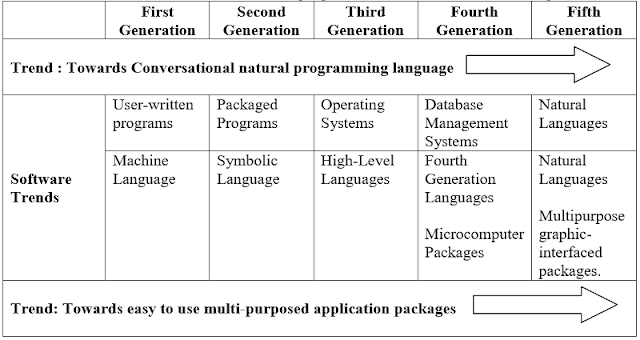Programming Languages
Programming Language is a set of rules that provides a way of instructing the computer to perform certain operations. Programming languages are said to be lower or higher, depending on whether they are closer to the language the computer itself uses or to the language that people uses.We can study the programming languages under five levels (or generations) of language:
- Machine Languages / First generation Languages
- Assembly languages / 2nd Generation Languages
- Procedural Languages/ Third-generation Languages
- Problem-oriented Languages / Fourth generation Languages
- Natural Languages / Fifth Generation Languages.
The characteristics & trends of these five languages are summarized in the following table:
 |
Characteristics of Programming Languages |
Computer programming languages are developed with the primary objectives without the need to know in detail the internal structure of the computer.
Machine Language
A program written using the binary codes specified for a processor's operations and absolute binary addresses is known as machine language of the computer. The programs written in Machine Languages are machine dependent. Programming using Machine Language is very tedious and time consuming. The programmer must keep track of a tremendous amount of detail and one must understand the technical operations of the computer. Programming in machine code has one advantage over programming at other language levels - its execution is very fast and efficient because the computer can accept the machine code as it is.Assembly Language
Assembly languages are also known as symbolic languages as they use abbreviations or mnemonic code which replace the Os and ls of machine language. An assembly language has a one-to-one correspondence with the machine language of a computer and is thus machine dependent. Assembly languages are more standardized and easier to use than machine languages. Though more standardized than machine languages, assembly languages are still machine dependent.High Level Languages
High level languages are the programming languages that use predefined common English words and clauses to write a program. They assisted programmers by reducing further the number of computer operations details they has to specify, so that they could concentrate more on the logic needed to solve the problem. We can classify the high level languages into three levels:- Procedural-oriented or third generation
- Problem-oriented or fourth generation
- Natural or fifth generation
Procedural oriented Languages
General-purpose programming languages are called procedural languages or third generation languages. They are the languages such as Pascal, BASIC, COBOL, and FORTAN, C which are designed to express the logic, the procedure, of a problem. Because of their flexibility, procedural languages are able to solve a variety of problems. More focus is given to modulewhile programming in Procedural-oriented languages.
Problem-oriented Languages
Fourth-generation languages are also known as problem-oriented languages. These are the languages designed to solve specific problems or develop specific applications by enabling one to describe what he wants rather than step-by-step procedures for getting there. Thus the problem should be considered most rather than procedures so as to get the solution to the particular problem. Visual Basic and PERL are Problem-oriented languages. These languages may be categorized into several kinds of application development tools:- Personal computer application software
- Query languages and report generators
- Decision support system and financial planning languages
- Application generators
Natural Languages
Natural languages are very near to the human conversational language. Natural languages are still in the development stages. These languages will be used most in the areas of artificial intelligence and expert systems. Natural languages have two characteristics:- They are designed to make the connections that humans have with computers more natural — more human like.
- They are designed to allow the computer to become "smarter" — to actually simulate the learning process by remembering and improving upon earlier information.
Two popular natural languages are LISP and PROLOG.
Compilers and Interpreters
Compiler is a program that translates source code into object code. The compiler takes the entire piece of source code and collects and recognizes the instructions. In contrast, the interpreter analyzes and executes each line of source code in succession, without looking at the entire program. The advantage of interpreters is that they can execute a program immediately butcompilers require some time before an executable program emerges. However, programs produced by compilers run much faster than the same programs executed by an interpreter.

Post A Comment:
0 comments so far,add yours